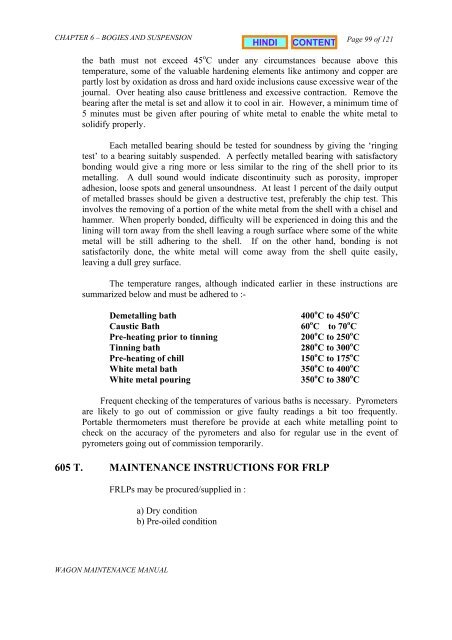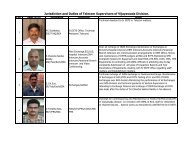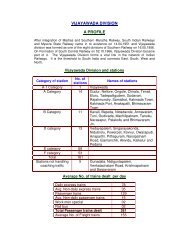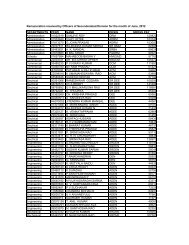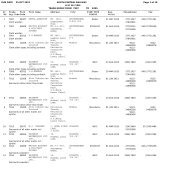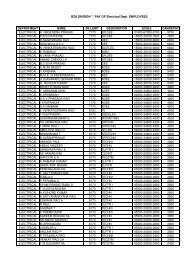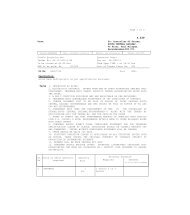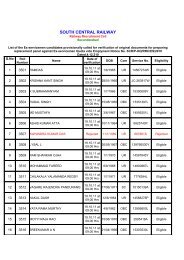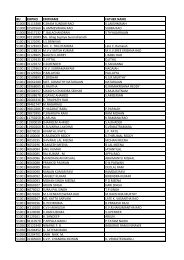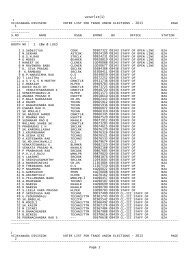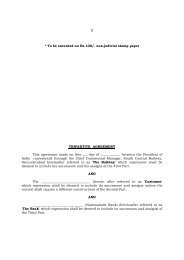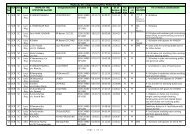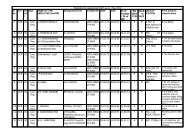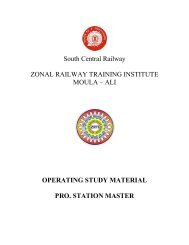BOGIES AND SUSPENSION - South Central Railway
BOGIES AND SUSPENSION - South Central Railway
BOGIES AND SUSPENSION - South Central Railway
Create successful ePaper yourself
Turn your PDF publications into a flip-book with our unique Google optimized e-Paper software.
CHAPTER 6 – <strong>BOGIES</strong> <strong>AND</strong> <strong>SUSPENSION</strong><br />
WAGON MAINTENANCE MANUAL<br />
Page 99 of 121<br />
the bath must not exceed 45 o C under any circumstances because above this<br />
temperature, some of the valuable hardening elements like antimony and copper are<br />
partly lost by oxidation as dross and hard oxide inclusions cause excessive wear of the<br />
journal. Over heating also cause brittleness and excessive contraction. Remove the<br />
bearing after the metal is set and allow it to cool in air. However, a minimum time of<br />
5 minutes must be given after pouring of white metal to enable the white metal to<br />
solidify properly.<br />
Each metalled bearing should be tested for soundness by giving the ‘ringing<br />
test’ to a bearing suitably suspended. A perfectly metalled bearing with satisfactory<br />
bonding would give a ring more or less similar to the ring of the shell prior to its<br />
metalling. A dull sound would indicate discontinuity such as porosity, improper<br />
adhesion, loose spots and general unsoundness. At least 1 percent of the daily output<br />
of metalled brasses should be given a destructive test, preferably the chip test. This<br />
involves the removing of a portion of the white metal from the shell with a chisel and<br />
hammer. When properly bonded, difficulty will be experienced in doing this and the<br />
lining will torn away from the shell leaving a rough surface where some of the white<br />
metal will be still adhering to the shell. If on the other hand, bonding is not<br />
satisfactorily done, the white metal will come away from the shell quite easily,<br />
leaving a dull grey surface.<br />
The temperature ranges, although indicated earlier in these instructions are<br />
summarized below and must be adhered to :-<br />
Demetalling bath 400 o C to 450 o C<br />
Caustic Bath 60 o C to 70 o C<br />
Pre-heating prior to tinning 200 o C to 250 o C<br />
Tinning bath 280 o C to 300 o C<br />
Pre-heating of chill 150 o C to 175 o C<br />
White metal bath 350 o C to 400 o C<br />
White metal pouring 350 o C to 380 o C<br />
Frequent checking of the temperatures of various baths is necessary. Pyrometers<br />
are likely to go out of commission or give faulty readings a bit too frequently.<br />
Portable thermometers must therefore be provide at each white metalling point to<br />
check on the accuracy of the pyrometers and also for regular use in the event of<br />
pyrometers going out of commission temporarily.<br />
605 T. MAINTENANCE INSTRUCTIONS FOR FRLP<br />
FRLPs may be procured/supplied in :<br />
a) Dry condition<br />
b) Pre-oiled condition


